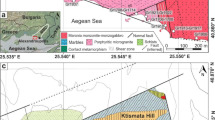Abstract
Mesothermal vein-type Sb mineralization in the Rheinisches Schiefergebirge, Germany, is characterized by two different mineralization styles, which are (1) extensional quartz-stibnite vein systems, and (2) (Cu)–Pb–Sb sulphosalt assemblages in overprinted pre-existing Pb–Zn veins. A detailed Pb isotope study of 52 representative samples from both mineralization types indicates distinct compositional patterns. (Cu)–Pb–Sb sulphosalts (meneghinite, boulangerite, bournonite) formed by reaction/remobilization are characterized by Pb isotope compositions (206Pb/204Pb=18.179–18.223), which are identical to the precursor galena (206Pb/204Pb=18.168–18.223). The Pb isotope composition of sulphosalt minerals in these vein systems was controlled by lead inherited from pre-existing galena. Stibnite and Pb-sulphosalts (zinkenite, semseyite, plagionite) formed in quartz–stibnite vein systems display Pb isotope ratios (206Pb/204Pb=18.250–18.354), which are more radiogenic than galenas from Variscan Pb–Zn ore veins (206Pb/204Pb=18.162–18.303). Detailed small-scale investigation of thrust zones hosting Pb–Zn ores and crosscutting quartz–ankerite fissure veins (Ramsbeck deposit) indicates that the Pb isotope compositions of recrystallized (galena) and remobilized phases (boulangerite, semseyite, bournonite) are arranged along a linear trend. This is interpreted as mixing between primary galena with 206Pb/204Pb≅18.206 and overprinting hydrothermal fluids with a more radiogenic composition (206Pb/204Pb≥18.354), expressed by intermediate compositions (206Pb/204Pb=18.256–18.334) of newly-formed sulphosalts. The Pb isotope systematics of the vein-type Sb mineralization is in accordance with a model of Pb extraction from similar crustal sources (Palaeozoic sedimentary sequences) at different times.
Similar content being viewed by others
Author information
Authors and Affiliations
Additional information
Electronic Publication
Rights and permissions
About this article
Cite this article
Wagner, T., Schneider, J. Lead isotope systematics of vein-type antimony mineralization, Rheinisches Schiefergebirge, Germany: a case history of complex reaction and remobilization processes. Min Dep 37, 185–197 (2002). https://doi.org/10.1007/s00126-001-0211-1
Received:
Accepted:
Published:
Issue Date:
DOI: https://doi.org/10.1007/s00126-001-0211-1




